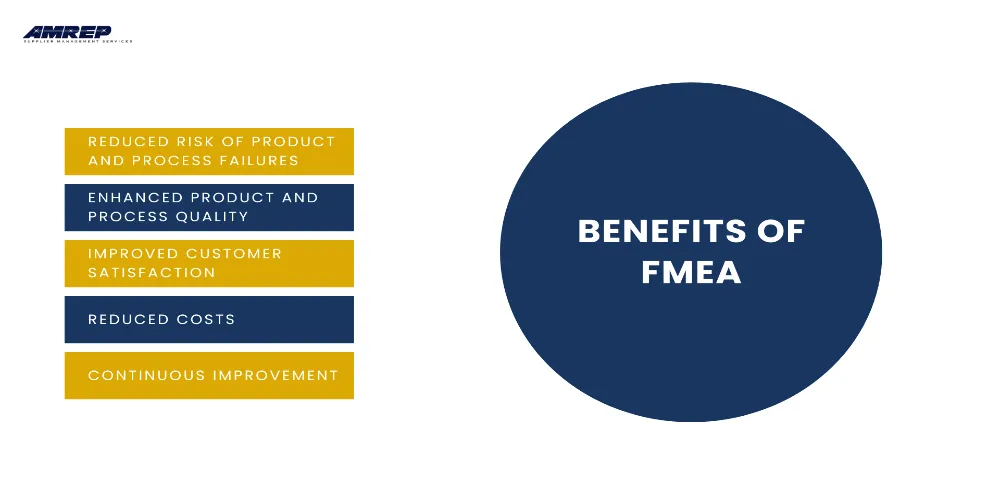Difference Between Quality Control and Quality Inspection
When you’re working with quality management professionals, you probably hear the terms ‘quality control’ and ‘quality inspection’ used a lot...
By AMREP | Posted on February 21, 2024

Failure Mode and Effects Analysis (FMEA) is an essential tool used for ensuring product quality and reliability. It offers a method for identifying, analyzing, and preventing potential failures in a product or manufacturing process. This guide gives you an overview of how the tool is used.
FMEA is a quality assurance tool that proactively identifies potential failure modes, assesses their severity and likelihood of occurrence, and evaluates the effectiveness of existing controls in preventing or detecting failures. By proactively addressing potential failures early in the design or process development phase, FMEA helps reduce the risk of costly rework, delays, and customer dissatisfaction.
A Failure Mode and Effects Analysis (FMEA) can be performed at different stages of a product, process, or service life cycle. Some of the situations that may require an FMEA are:
The FMEA process typically involves the following steps:
| Step | Description |
|---|---|
| Define the Scope | Clearly define the product, process, or system to be analyzed, establishing boundaries and outlining specific components or steps. |
| Assemble the FMEA Team | Form a cross-functional team of experts with diverse knowledge and experience in the product, process, or system under review. |
| Identify Functions | Identify the intended functions or objectives of each component or step within the scope. |
| Identify Potential Failure Modes | Brainstorm and list potential ways in which each component or step could fail to fulfill its intended function. |
| Analyze Effects of Failure | For each potential failure mode, describe the potential consequences or effects on the product, process, or system, considering safety, performance, and customer satisfaction. |
| Assess Severity | Assign a severity rating (typically on a scale of 1 to 10) to each failure mode, reflecting the seriousness of its potential impact. |
| Identify Potential Causes | Identify the potential root causes or mechanisms that could lead to each failure mode. |
| Assess Occurrence | Assign an occurrence rating (typically on a scale of 1 to 10) to each potential cause, reflecting the likelihood of its occurrence. |
| Identify Current Controls | Identify existing controls or measures in place to prevent or detect each failure mode. |
| Assess Detection | Assign a detection rating (typically on a scale of 1 to 10) to each control, reflecting its effectiveness in preventing or detecting the associated failure mode. |
| Calculate Risk Priority Number (RPN) | Multiply the severity, occurrence, and detection ratings to obtain the RPN, a numerical representation of the overall risk associated with each failure mode. |
| Prioritize Actions | Prioritize actions based on the RPN, focusing on addressing failure modes with high risk scores. |
| Develop Recommended Actions | Propose actions to eliminate or reduce the likelihood of high-risk failure modes. |
| Implement Actions | Implement the recommended actions and monitor their effectiveness in reducing risk. |
| Review and Update | Regularly review and update the FMEA as the product, process, or system evolves. |
FMEA offers numerous benefits, including:

In AMREP’s production process quality engineering services, FMEA is typically used by manufacturing engineers, quality engineers, process engineers, design engineers, and product engineers to analyze the reliability and quality of the products being manufactured. We use it at production sites to help prevent product failures and manufacturing problems before the issues escalate through the product manufacturing and supply chain.
Read More : How FMEA Enhances Inspection Methods
Contact Us To See What We Can Do
Call Us
Mon - Sat 9.00 - 18.00
Sunday Closed


15 - February 2023
15
February
2023
When you’re working with quality management professionals, you probably hear the terms ‘quality control’ and ‘quality inspection’ used a lot...

14 - February 2023
14
February
2023
New Product Introduction (NPI) is the process of taking a product from the initial concept stage through to mass production and commercialization ...

14 - February 2023
14
February
2023
Lean and Six Sigma are two process improvement tools that can be used separately or together to enhance efficiency and quality ...
